10 drip campaign examples for inspiration
1. The Mediterranean Dish’s lead magnet sequence
A lead magnet email sequence is a series of emails that are sent to those who sign up to receive resources, such as e-books, checklists, etc.
The Mediterranean Dish utilizes this sequence to kickstart their relationship with a prospect.
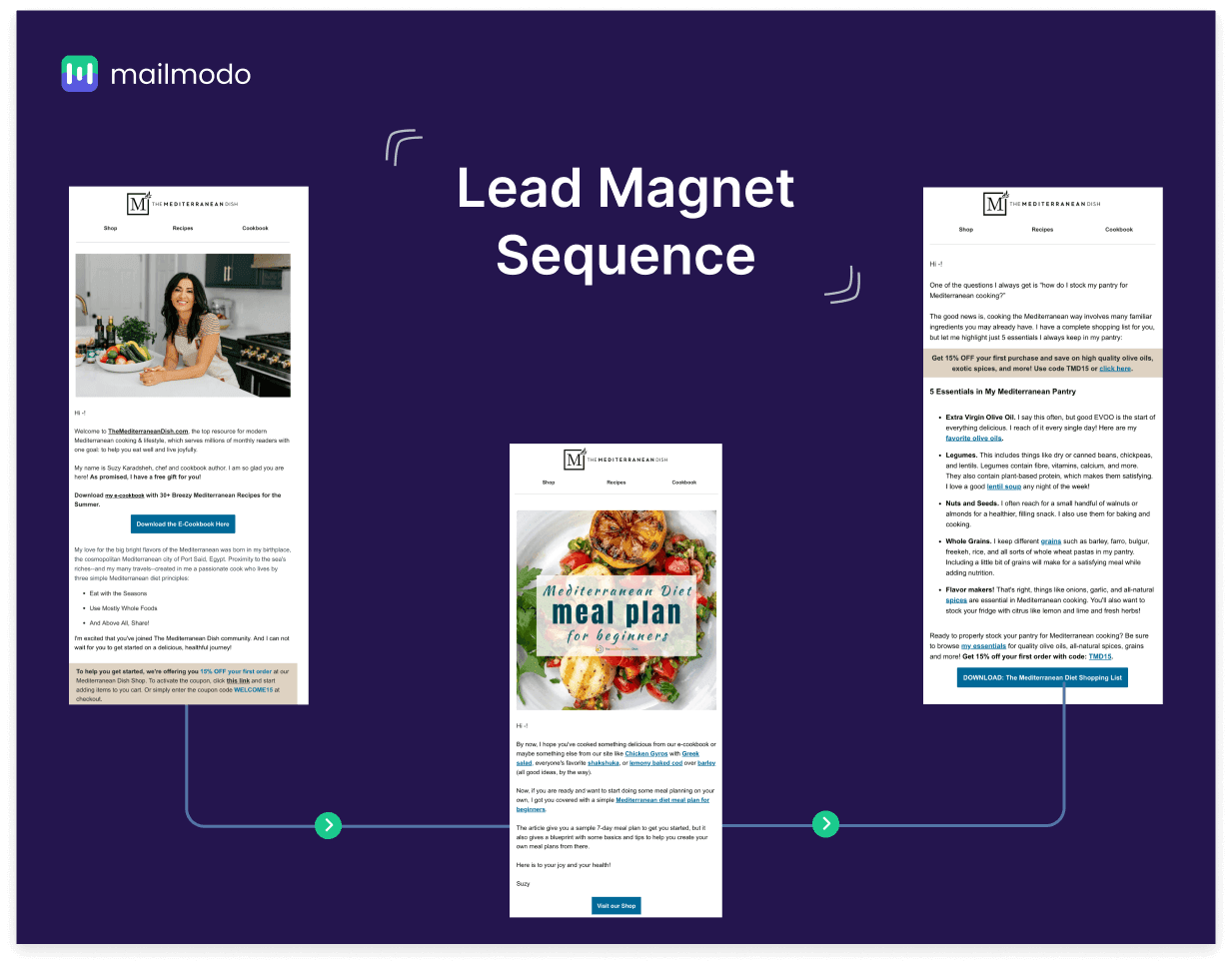
Email 1: The subscriber receives the e-cookbook they signed up for and a 15% discount coupon for their first purchase.
Email 2: This email hopes that the recipient has used the recipes from the book and provides them with a link to a sample 7-day meal plan from the brand’s blog.
Email 3: The final email in the sequence provides the recipient with a shopping list of ingredients and a reminder of the 15% discount that they can use to buy these on the brand’s website
What we like: All the emails used by The Mediterranean Dish in this series provide high value to the recipient. The emails convince the recipient to try a Mediterranean diet by providing them with several useful freebies and relevant content. This is a great way to build brand loyalty.
2. BÉIS’s product recommendation series
A product recommendation email sequence is generally used to acquaint the recipient with the various products/services you offer and reasons to buy them. This includes various types of social proof and offers the recipient can avail.
BÉIS’s drip email campaign consists of a series of well-designed emails featuring their bestsellers.
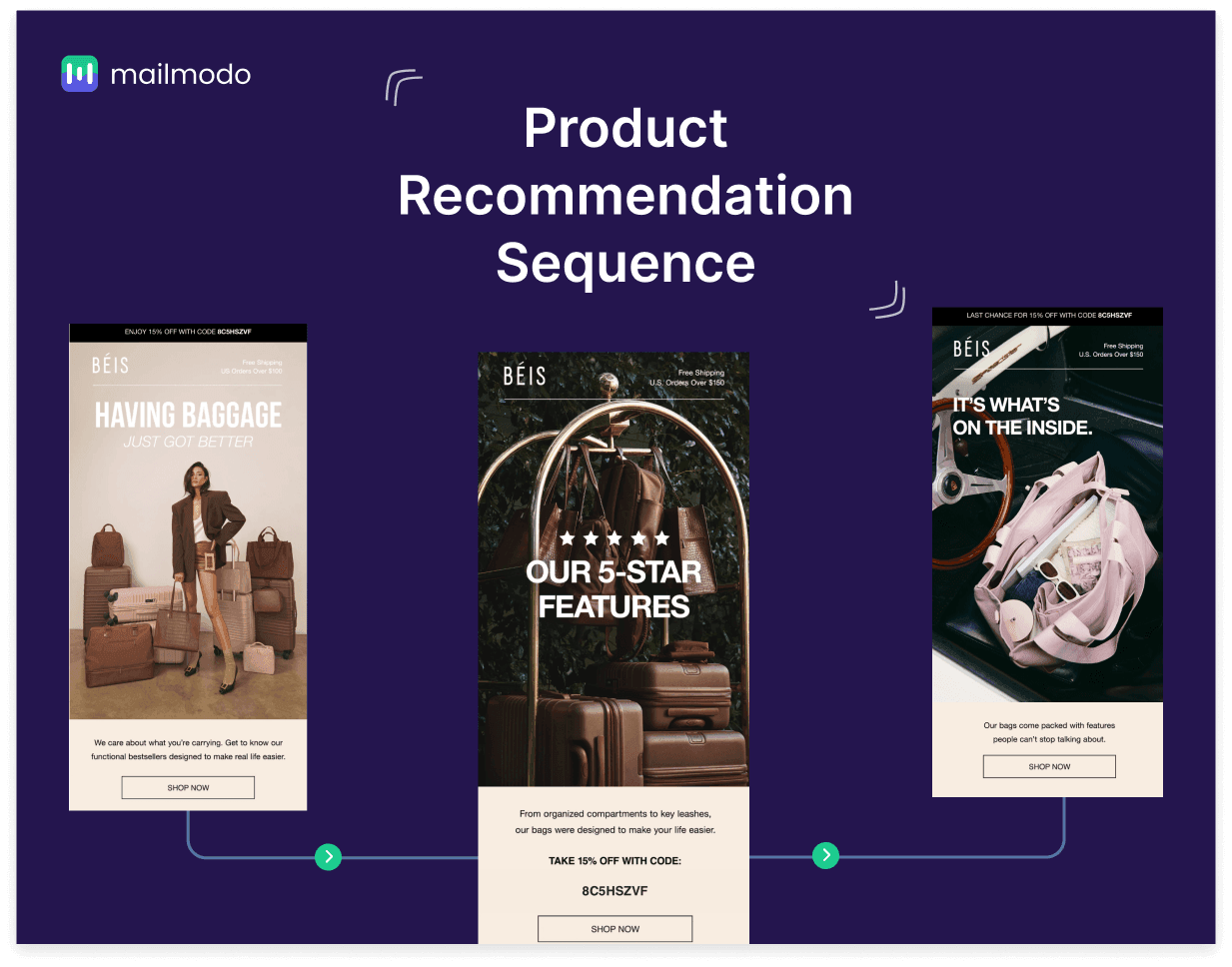
Email 1: The email features pictures of the brand’s bestsellers, with a humorous announcement: “having baggage just got better.” It also promises free shipping on orders above US $100 and a 15% discount code.
Email 2: The free shipping and discount offers are repeated, along with a series of positive customer reviews for their products.
Email 3: The final email draws attention to the large storage capacity of the bag using a picture and features the media mentions that the brand has received.
What we like: BÉIS uses great design and copywriting in its emails, instantly attracting the recipients' attention. The use of social proof is also effective in building trust and prompting them to check out the products.
💡 Related guide: What Is a Product Recommendation Email With Best Practices
3. Camilla’s welcome series
A welcome email sequence is triggered when someone signs up on your website or creates a new account. This sequence generally introduces your brand to the subscribers and provides them with welcome offers.
Camilla's welcome series aims to showcase the variety of their clothing line for a new customer.
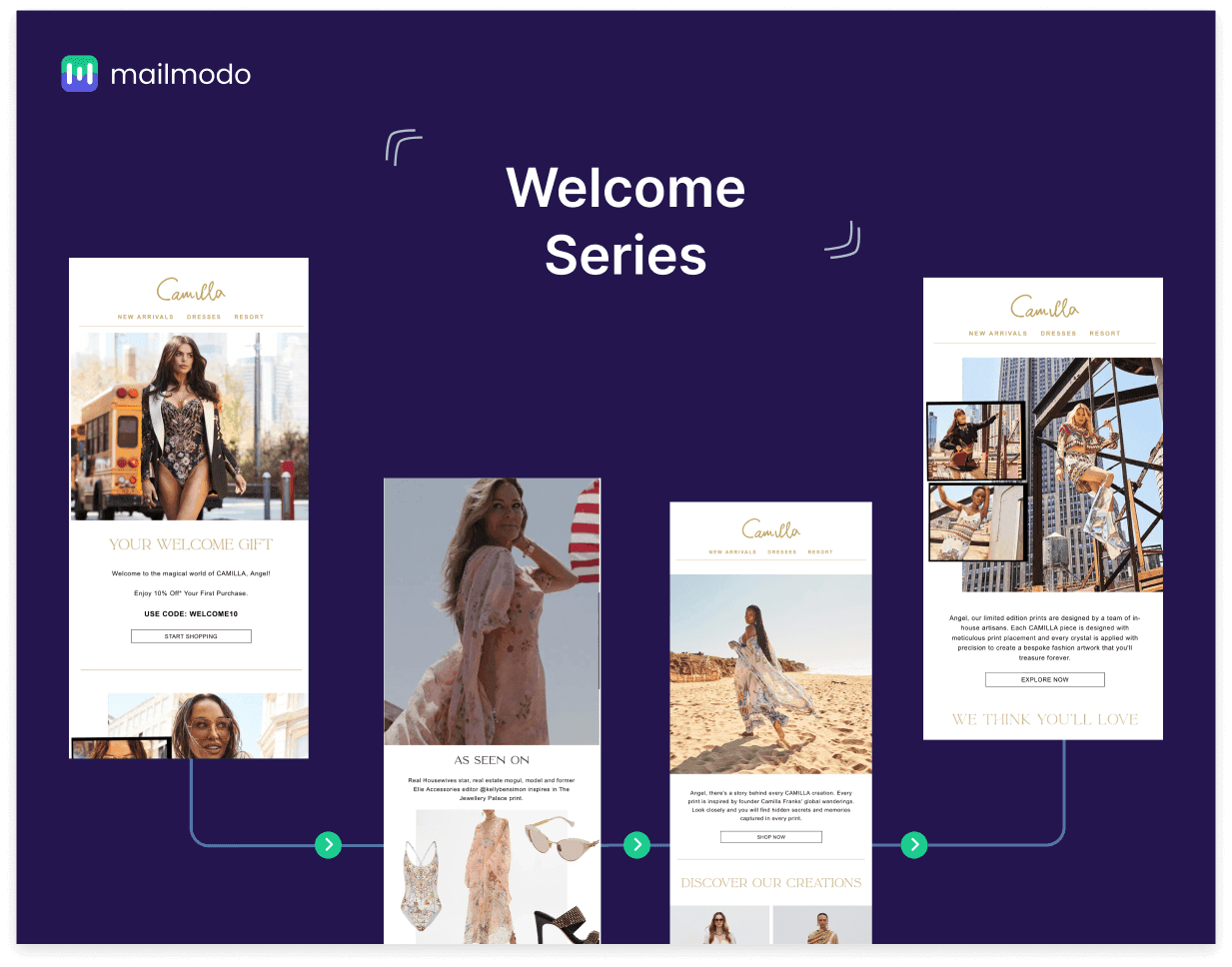
Email 1: The brand provides the recipient with a welcome gift in the form of a discount code and introduces their founder.
Email 2: The email narrates the brand's story and says how the founder's global wanderings inspire each design. It also gives them product recommendations.
Email 3: This email features a prominent celebrity who has endorsed the brand and an attractive breakup of the featured outfit.
Email 4: The brand’s limited edition collection is introduced, with more details on their attention to detail. Additional product recommendations are also provided.
What we like: Camilla’s welcome sequence has a personal touch and is written in a way that allows the user to feel connected with the founder’s vision, which makes the emails feel more personal and the recipients more connected to the brand.
To create your own welcome email sequence, check out this insightful chat:
4. Mindvalley’s post-event nurture series
Post-event nurture emails allow you to convert a potential customer who has recently engaged with the your brand through an event, such as a webinar or an online summit.
Mindvalley’s post-webinar email drip campaign is designed in a step-by-step manner to persuade the user to join their paid membership program.
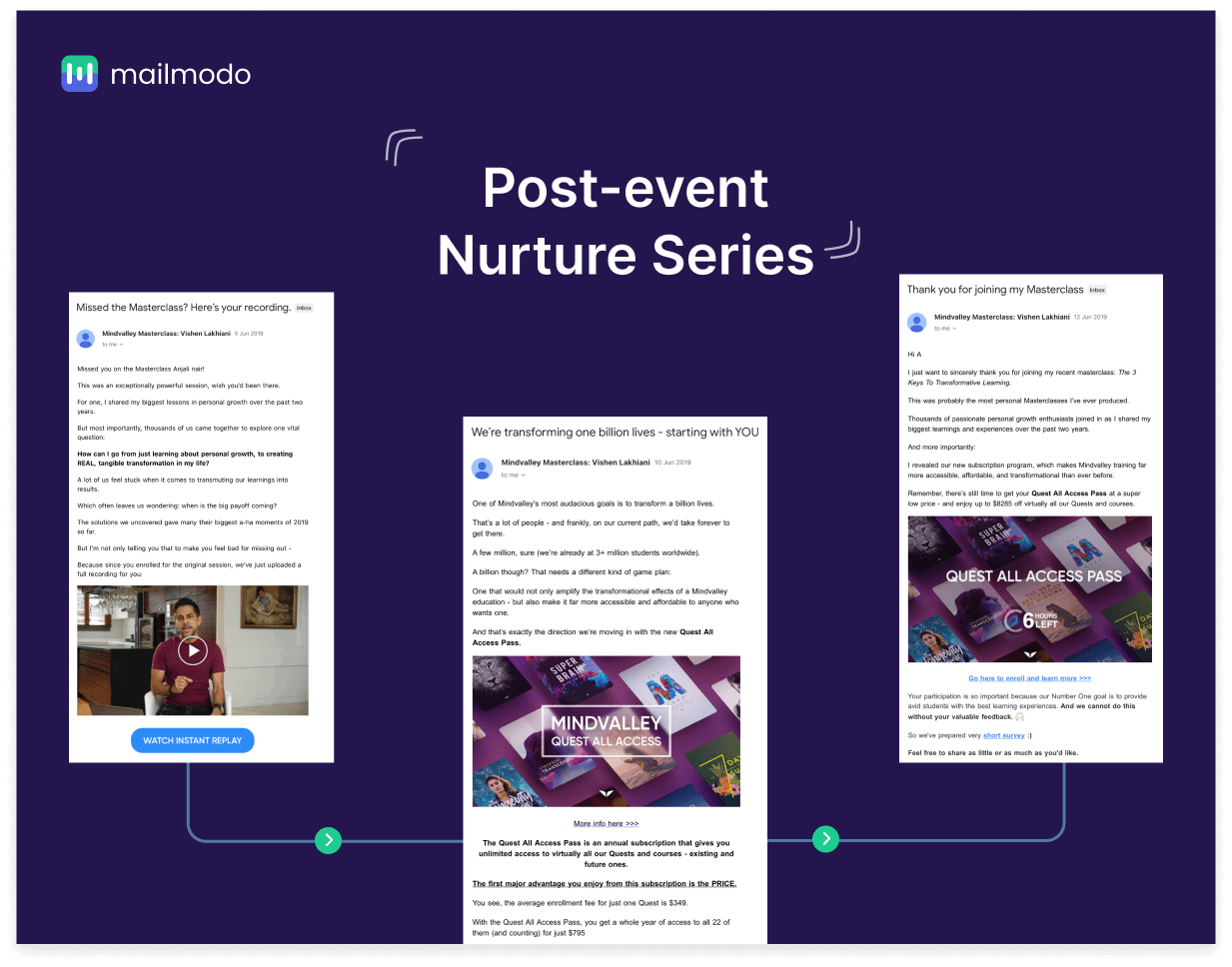
Email 1: The user is provided with the recording of the webinar that they missed.
Email 2: This email states an audacious goal to transform one billion lives and urges the user to become part of their movement by joining their membership program.
Email 3: The brand once again thanks the user for joining the webinar and reminds them that they have just 6 hours left to avail the membership pass at a discounted rate.
What we like: The emails in this series use FOMO to persuade the user to join their membership program. It also addresses the pain points of the recipient directly and promises a solution to resolve them.
💡 Related guide: 6 Steps to Create an Effective Event Email Marketing Strategy
5. SoWell’s back-in-stock sequence
A back-in-stock drip campaign is aimed at notifying customers about a restock and encouraging them to grab the product as soon as possible.
SoWell is a wellness brand whose back-in-stock sequence consists of two emails spotlighting their dietary supplement, Calm, which has been restocked.
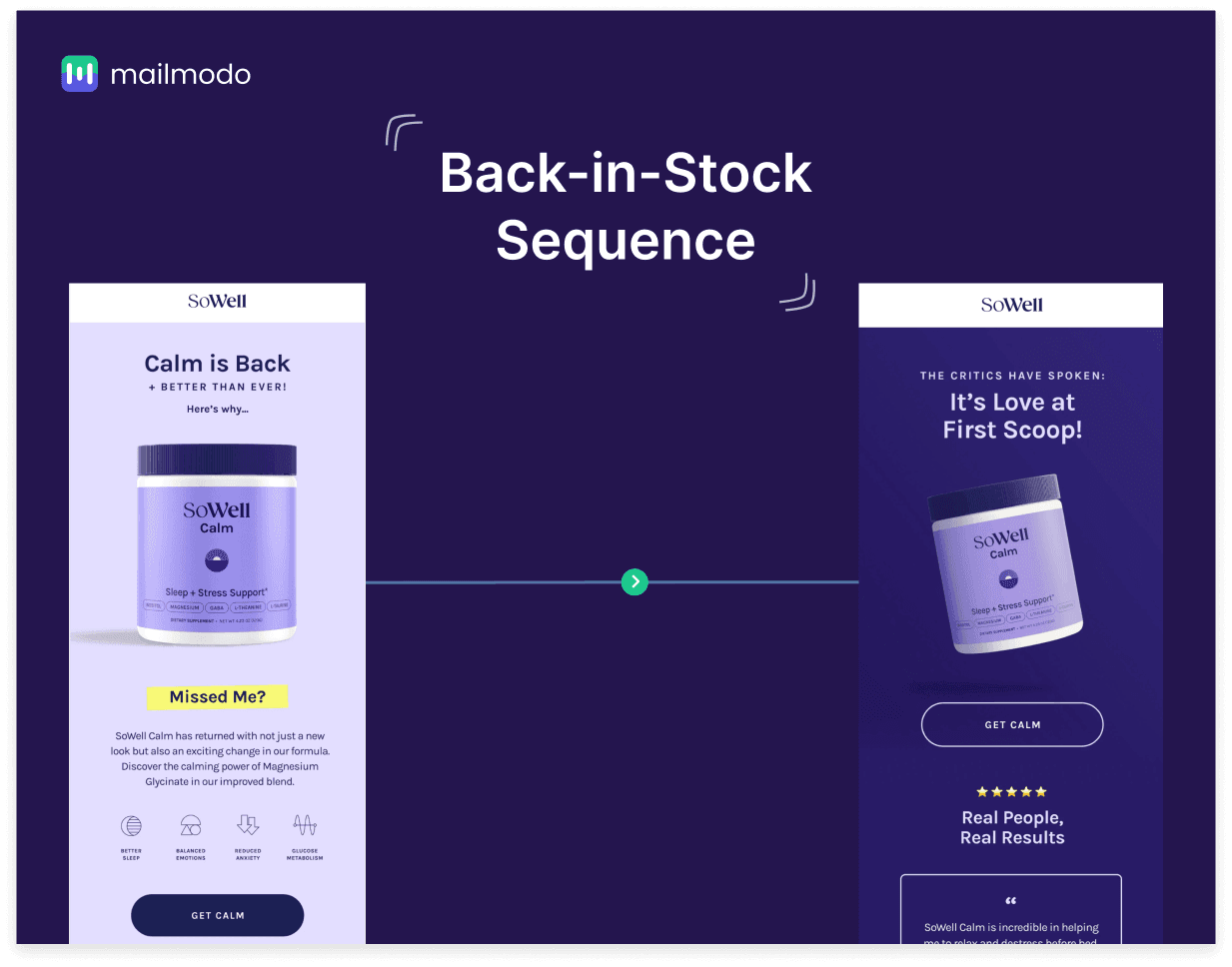
Email 1: The first email announces that Calm is back with a new look and formula. It also details the ingredients and benefits of the product.
Email 2: This email features customer product reviews to persuade the recipient to buy the product.
What we like: The emails use a simple design and color scheme that emphasizes the product. The emails also feature the key ingredients and benefits of the product in a simple layout so that the users can know them at first glance.
6. Stegmann’s cart abandonment series
Abandoned cart drip campaigns are meant to nudge those customers who had added products to their cart but didn’t proceed with the purchase. These emails usually provide users with additional offers to encourage a purchase.
Stegmann’s abandoned cart series aims to secure a purchase by showcasing similar products and stating that the item could get sold out soon.
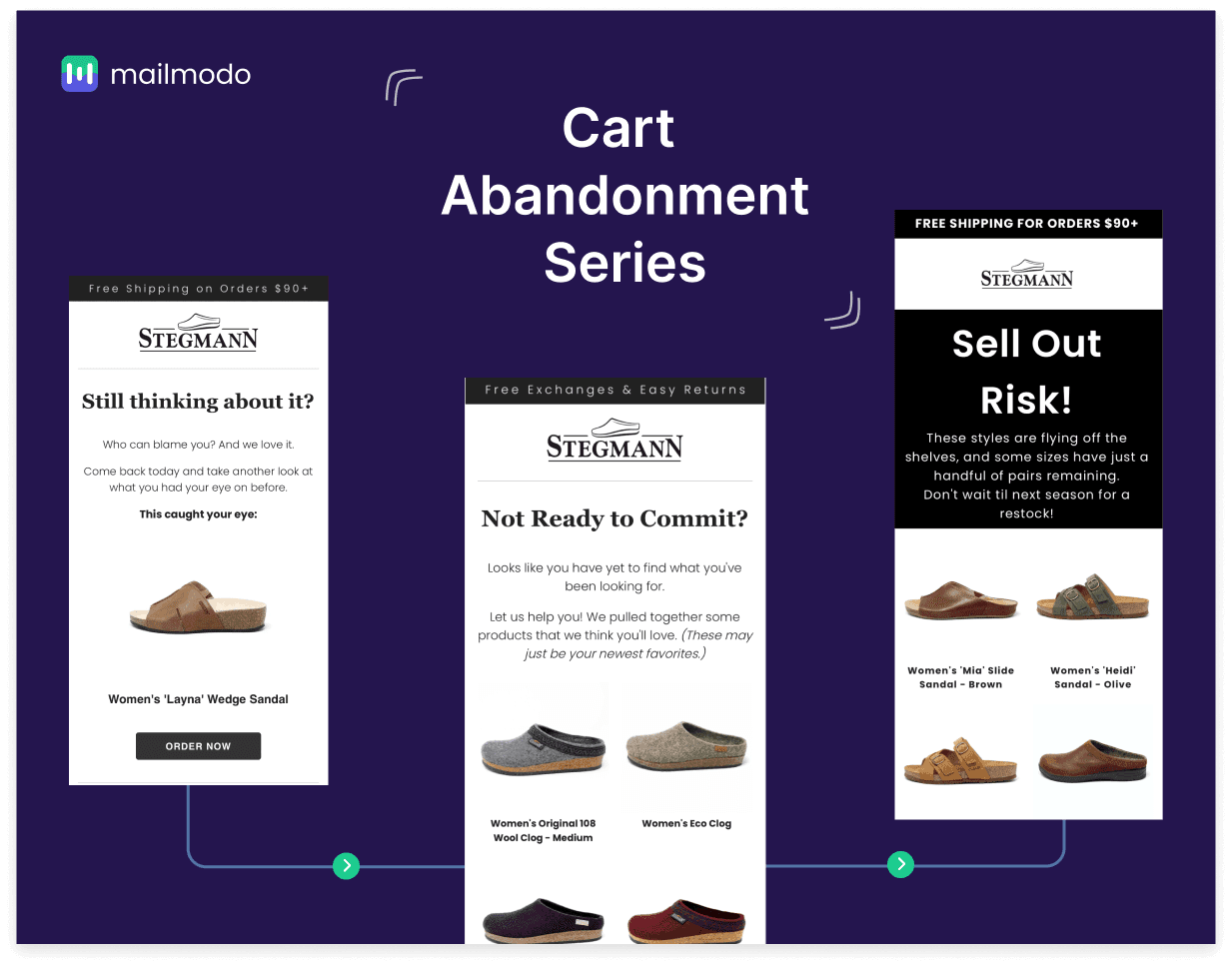
Email 1: The product in the recipient’s cart is spotlighted and presented as a great choice.
Email 2: Due to the lack of further action by the recipient, the second email suggests that the user may not have found the right product yet and recommends other similar products.
Email 3: The third email encourages the user to make a purchase immediately because the products are “flying off the shelves.”
What we like: Stegmann’s drip emails in this series recognize that the user might have decided not to buy an item because they were unsure of the model they selected. They creatively use the abandoned cart sequence to showcase their wide collection to rekindle the user’s interest.
💡 Related guide: 12 Abandoned Cart Email Examples That Got Them to Buy
7. EQVVS’s browse abandonment series
Browse abandonment emails are sent to potential customers who view your products without buying or adding them to the cart.
EQVVS’s browse abandonment drip sequence is designed to bring the potential customer back to their website.
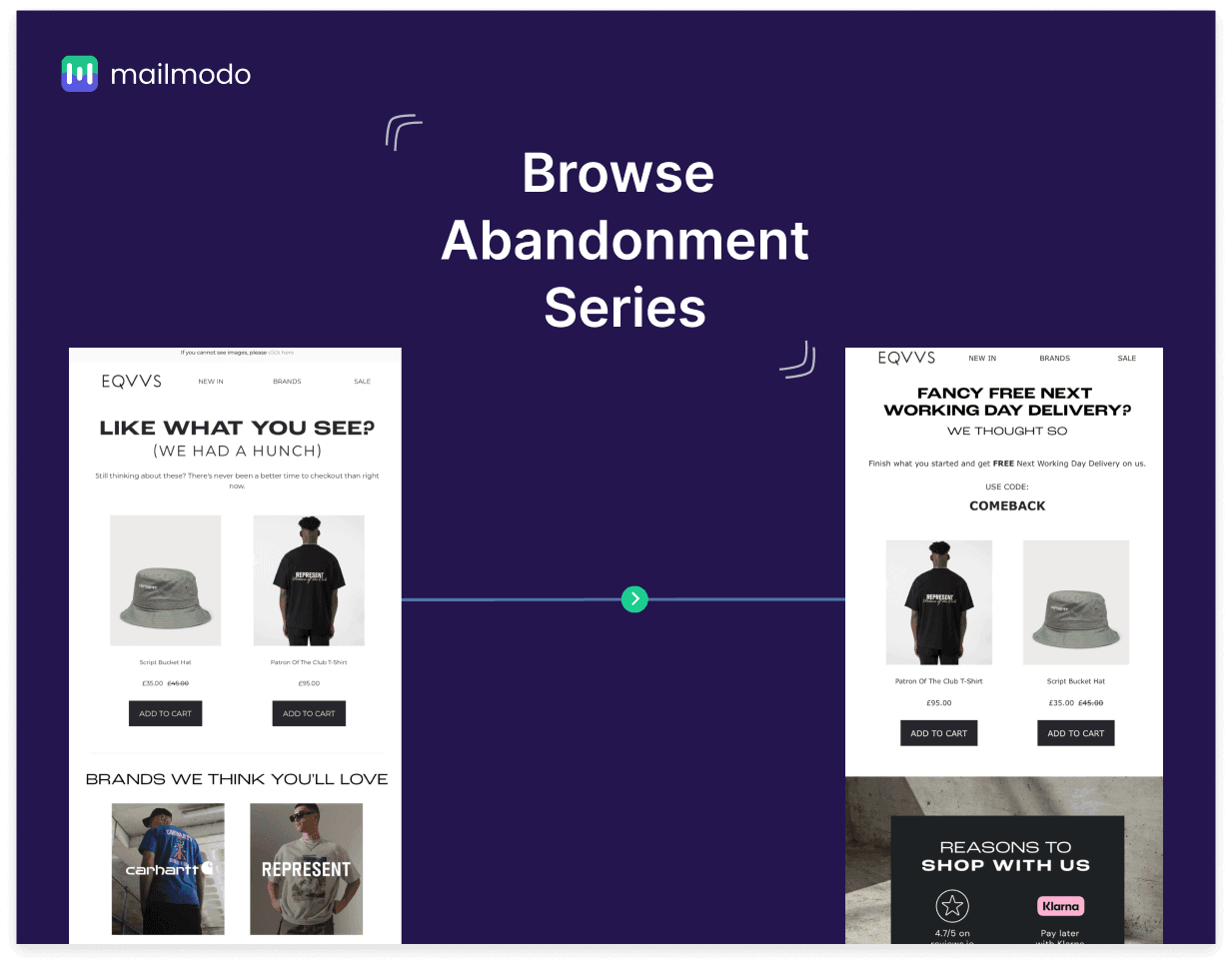
Email 1: This email showcases the products that the user has been browsing and urges them to checkout. It also features a list of brand recommendations.
Email 2: To further encourage a sale, the brand offers the user free next-day delivery using the coupon code "COMEBACK" and a simple infographic of reasons to shop from the brand.
What we like: The brand uses a simple design that highlights its products and provides links to the brand’s new arrivals, other brands, and live sales in the header of the email. This encourages the user to visit their website again.
8. BeforeYouSpeak Coffee’s milestone series
Milestone email sequences provide customers with offers on various milestones of your brand or the customer, like anniversaries, birthdays, etc.
BeforeYouSpeak Coffee makes use of a drip campaign to promote its birthday sale.
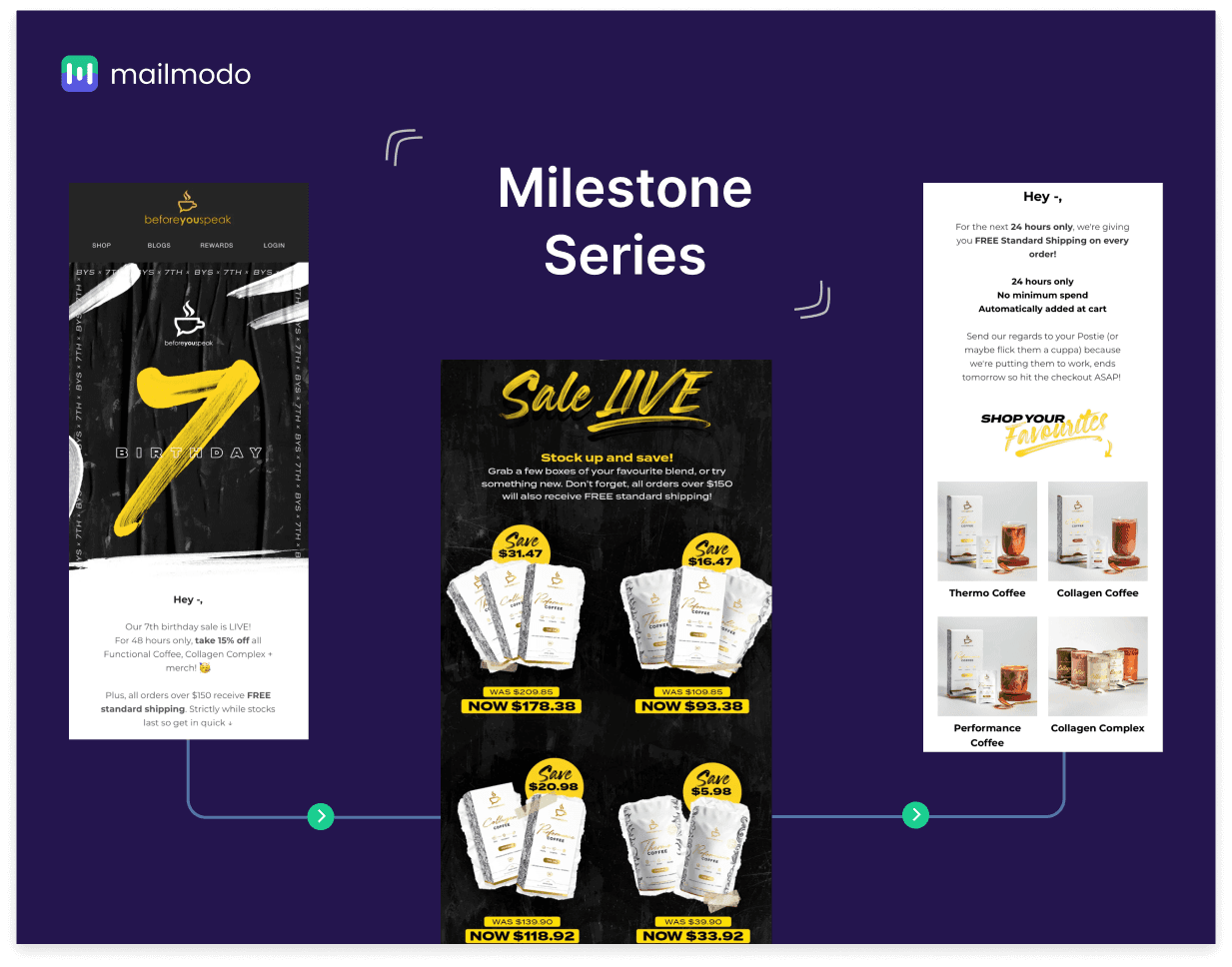
Email 1: The 48-hour 7th birthday sale of the brand is announced. The customers are given a 15% discount on select products and free standard shipping on orders above $150.
Email 2: The recipient is reminded of the sale with the catalog of the products on sale. The original and the discounted prices of each item is shown.
Email 3: The final email reminds the user that they are getting free shipping on no minimum order value only for the last 24 hours. The recipient is encouraged to “shop their favorites” and provided with a list of product recommendations.
What we like: This email series provides potential customers with great offers while creating a sense of urgency for them to make a purchase. The products on offer are clearly presented with their prices to encourage the user to consider the deals.
9. WPeka’s feedback email sequence
A feedback email series helps you get valuable suggestions and feedback that can help you improve your product. They can also be used to collect customer reviews to increase your brand visibility.
WPeka's feedback series aims to secure reviews of their brand on Trustpilot.
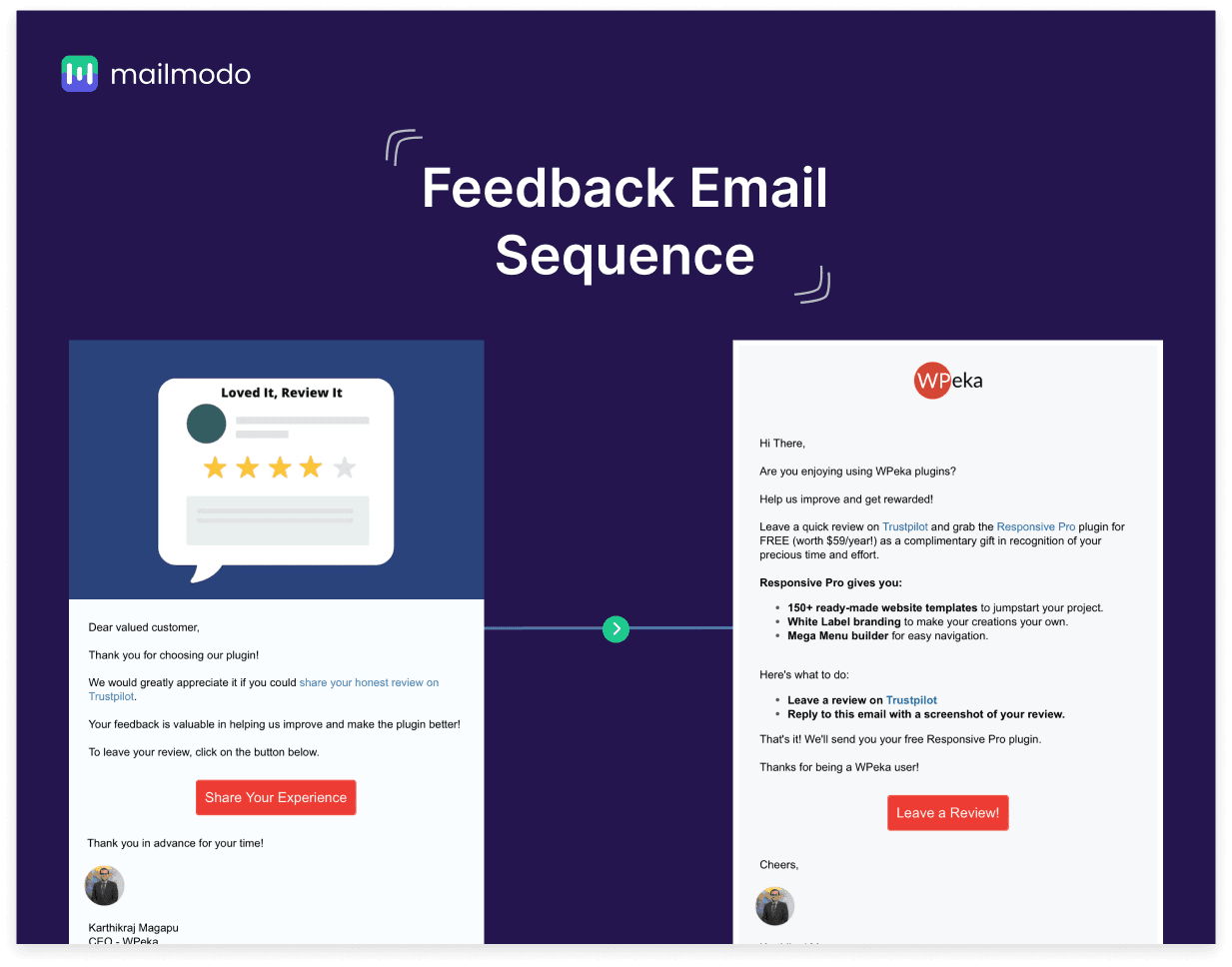
Email 1: The existing user of the WPeka plugin is asked to provide an honest review on Trustpilot so that the brand can improve its product.
Email 2: The email reminds the user to post their review and offers them the ResponsivePro plugin as a free reward for the review.
What we like: WPeka's use of a feedback drip campaign is a great way of delivering additional value to the customer through a reward. The email mentions the worth of the free gift and provides the user with the key benefits that the gift can provide them.
10. Grammarly’s win-back series
A win-back sequence is a series of emails sent to inactive customers to encourage re-engagement.
Grammarly’s win-back series is aimed at customers who have stopped using their browser extension.
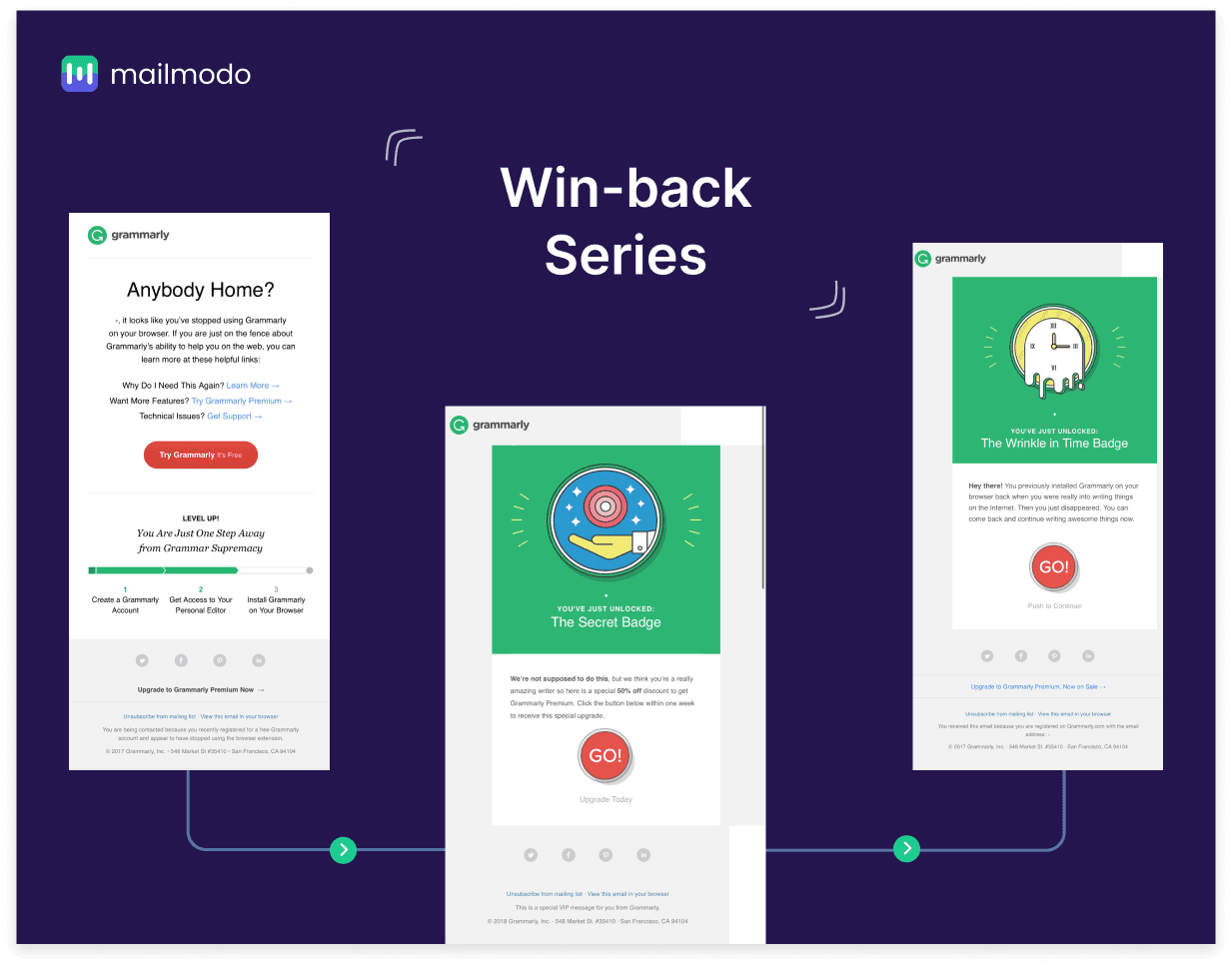
Email 1: An email full of spelling and grammar mistakes informs the user that they have stopped using Grammarly to humorously convey the importance of their product. A progress bar is also included to show the user that they are just one step away from being able to use Grammarly for free.
Email 2: The last email announces that the user has unlocked the “wrinkle in time badge” for “disappearing” and not using the brand’s product. A prominent red “GO!” button prompts the user to re-engage with the brand.
Email 3: Another “badge” is given to the user in the form of a supposedly secret 50% discount on Grammarly Premium for a limited time period.
What we like: Grammarly’s drip campaign is a great example of appropriate humor, engaging copywriting, and interactive elements such as gamification to win back its customers. This creates a sense of curiosity in the user to give the brand another chance.
Plan your next drip campaign with Mailmodo
Drip campaigns can effectively create a strong brand presence in your subscribers' inboxes. A successful drip campaign has various elements that allow emails to reach inboxes at the right time and sequence.
If these sequences and email drip campaign examples have inspired you to design a drip campaign for your brand, we have the perfect tool for you. Mailmodo allows you to create and set up customer journeys and drip campaigns that can be triggered by various user interactions. The visual journey builder makes it easy and fun to design your drip campaigns, so you can easily create stunning campaigns and have fun while doing it.
Create your drip campaign with Mailmodo
Conclusion
Drip campaigns go beyond simple marketing. They allow you to engage, nurture, and build a relationship with your audience meaningfully. The examples in this guide illustrate how brands use drip campaigns and how you can use some of the common email series in new and refreshing ways to suit your needs. With the right tools and approach, you can utilize drip campaigns to build a base of loyal customers for your brand and take your business toward success.





















